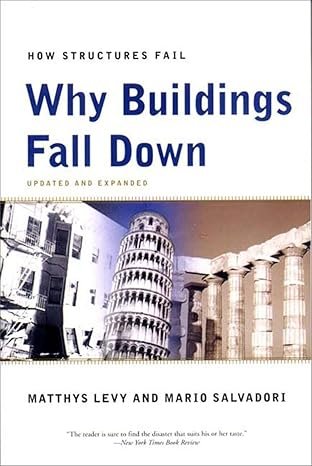Structural engineering is a lifelong learning journey.
Whether you’re a student, a PE candidate, or a seasoned professional, the right books can sharpen your skills, expand your knowledge, and open new career opportunities.
Here are the 10 most influential books—covering theory, design, failures, and innovation—that belong on every structural engineer’s shelf:
Part 1 : The Essentials
1. Design of Concrete Structures

Rating: ★★★★★ (5/5) – The Gold Standard for Concrete Design
Why This Book Matters
Widely regarded as the definitive textbook on reinforced concrete design
this book has educated generations of engineers.
Now in its 16th edition
it aligns with ACI 318-19 code updates and remains the reference for:
University courses
PE exam prep
Professional practice
Key Strengths
1. Code-Centric Approach
Directly ties theory to ACI 318 requirements
“Code Corners” highlight critical provisions
Updated for modern materials (HSC, FRP)
2. Exceptional Problem-Solving Focus
300+ worked examples with detailed commentary
500+ end-of-chapter problems (from basic to real-world)
Flowcharts for step-by-step design processes
3. Balanced Theory + Practice
Covers everything from crack control to seismic detailing
Special chapters on slabs, walls, and foundations
New content on *performance-based design*
Who Benefits Most?
Students: The clearest explanation of Whitney stress blocks and capacity design
Exam Takers: 30+ sample problems mirror NCEES PE exam format
Practitioners: Quick-reference design aids (e.g., column interaction diagrams)
Where to Buy:
2. Steel Design

Rating: ★★★★★ (5/5) – The Ultimate Guide to Modern Steel Design
Why This Book Stands Out
Widely adopted in universities and professional offices
Segui’s Steel Design is the most comprehensive resource for mastering LRFD and ASD methods according to AISC 360-22 specifications.
The 7th Edition cements its status as the go-to reference for:
University steel design courses
FE/PE exam preparation
Real-world structural engineering practice
Key Strengths
1. Unmatched Code Integration
Seamlessly incorporates AISC 360-22 updates throughout
Clear side-by-side comparisons of LRFD vs. ASD approaches
“Code Compliance” notes highlight critical requirements
2. Practical Problem-Solving Focus
200+ fully worked examples with detailed explanations
400+ end-of-chapter problems (including NCEES-style questions)
Step-by-step design flowcharts for beams, columns, and connections
3. Cutting-Edge Coverage
New material on direct analysis method (DM)
Expanded composite design content
Latest seismic and stability provisions
Who Benefits Most?
Students: Best resource for understanding plastic section modulus and block shear
Exam Candidates: 50+ example problems match PE exam format
Practitioners: Quick-reference design tables and connection details
Where to Buy:
3.Structural Engineering Reference Manual by Alan Williams

Rating: ★★★★★ (5/5) – The Definitive PE Exam Companion
Why This Book is Indispensable
Widely known as the “PE Exam Bible,” this manual has helped thousands pass the NCEES Structural Engineering exam. The 8th Edition covers all exam topics with unmatched clarity, making it essential for:
PE Exam candidates
SE Exam preparation
Daily office reference
Key Strengths
1. Complete Exam Coverage
Aligns 100% with NCEES exam specifications
Covers concrete, steel, masonry, timber, and seismic
Includes both breadth and depth sections
2. Exceptional Problem-Solving Tools
100+ step-by-step example problems
500+ practice questions with detailed solutions
Unique “Quick Reference” tabs for exam day
4. Practical Design Focus
Real-world design procedures for all major materials
Code references to ACI, AISC, NDS, and MSJC
Seismic detailing for IBC and ASCE 7
Who Needs This Book?
Exam Takers: The single most useful resource for PE/SE prep
Young Engineers: Excellent transition from academic to practical design
Consultants: Reliable quick-reference for code applications
Where to Buy:
Part 2 : Deepen Your Understanding
4. Why Buildings Fall Down

Rating: ★★★★★ (5/5) – The Definitive PE Exam Companion
Why This Book is Indispensable
Widely known as the “PE Exam Bible,” this manual has helped thousands pass the NCEES Structural Engineering exam.
The 8th Edition covers all exam topics with unmatched clarity, making it essential for:
PE Exam candidates
SE Exam preparation
Daily office reference
Key Strengths
1. Complete Exam Coverage
Aligns 100% with NCEES exam specifications
Covers concrete, steel, masonry, timber, and seismic
Includes both breadth and depth sections
2. Exceptional Problem-Solving Tools
100+ step-by-step example problems
500+ practice questions with detailed solutions
Unique “Quick Reference” tabs for exam day
3. Practical Design Focus
Real-world design procedures for all major materials
Code references to ACI, AISC, NDS, and MSJC
Seismic detailing for IBC and ASCE 7
Who Needs This Book?
Exam Takers: The single most useful resource for PE/SE prep
Young Engineers: Excellent transition from academic to practical design
Consultants: Reliable quick-reference for code applications
Where to Buy:
5. Theory of Plates and Shells

Rating: ★★★★★ (5/5) – The Definitive PE Exam Companion
Why This Classic Endures
First published in 1940, Timoshenko’s masterpiece remains the definitive work on plate and shell theory, used by:
Researchers in thin-shell structures
Aerospace/mechanical engineers
Advanced structural analysts
Key Strengths
1. Mathematical Rigor
Complete derivations of governing differential equations
Exact solutions for circular/rectangular plates
Buckling analysis of cylindrical shells
2. Practical Applications
Design methods for concrete domes & silos
Pressure vessel analysis techniques
Bridge deck behavior modeling
3. Timeless Pedagogy
Progressive difficulty (starts with beams → plates → shells)
300+ illustrative problems
Clear distinction between Kirchhoff and Mindlin plate theories
Who Needs This Book?
PhD Candidates: Essential for composite materials research
Offshore Engineers: Shell theory for LNG tanks & hulls
Seismic Specialists: Curved surface behavior in nuclear containment
Where to Buy:
6. Dynamics of Structures

Rating: ★★★★★ (5/5) – The Seismic Engineering Canon
Why This Book Reigns Supreme
Chopra’s seminal work dominates earthquake engineering education worldwide, serving as the gold standard for:
Graduate-level structural dynamics
PE/SE exam seismic preparation
Performance-based design professionals
Key Strengths
1. Unrivaled Clarity
Builds from single-DOF to complex MDOF systems
300+ derivations with physical interpretations
MATLAB examples for numerical implementation
2. Cutting-Edge Applications
Response spectrum analysis per ASCE 7-22
Soil-structure interaction methods
Base isolation and energy dissipation systems
3. Pedagogical Excellence
500+ end-of-chapter problems (20% seismic-focused)
Instructor slides available
Optional solutions manual
Who Absolutely Needs This?
Bridge Engineers: Modal analysis for long-span structures
Nuclear Facility Designers: Seismic qualification methods
Researchers: Benchmark problems for new damping technologies
Where to Buy:
7. Structures: Or Why Things Don’t Fall Down

Rating: ★★★★★ (5/5) – The Most Enjoyable Structural Engineering Book Ever Written
Why This Book is Special
Gordon’s masterpiece makes structural engineering delightfully accessible while maintaining technical accuracy.
It’s been inspiring future engineers since 1978 because:
It explains complex concepts through everyday analogies
Covers everything from bridges to biological structures
Makes you laugh while you learn
Key Strengths
1. Unmatched Clarity
Uses spider webs, ships, and dinosaurs to teach mechanics
Explains stress/strain like you’ve never heard before
Compares materials in memorable ways (why glass fails, why steel bends)
2. Surprising Depth
Covers elasticity, plasticity, and fracture mechanics
Discusses composite materials and fatigue
Includes historical engineering failures
3. Timeless Appeal
Perfect for beginners yet insightful for professionals
Required reading at Cambridge, MIT, and other top schools
Cited by engineers, biologists, and architects alike
Who Should Read This?
Students: The perfect intro before tackling textbooks
Teachers: Makes difficult concepts stick
Curious Minds: For anyone who wonders how things work
Where to Buy:
8. Structural Concrete: Theory and Design

Rating: ★★★★★ (5/5) – The Modern Concrete Engineer’s Bible
Why This Book Stands Out
Now in its 8th Edition, this comprehensive guide bridges theory and practice with up-to-date ACI 318-19 compliance, making it essential for:
Concrete design courses
PE/SE exam prep
Professional structural engineering practice
Key Strengths
1. Complete Code Integration
Full ACI 318-19 provisions with clear commentary
Side-by-side LRFD/ASD comparisons
Highlighted “Code Alerts” for critical requirements
2. Practical Design Focus
400+ worked examples including:
Two-way slab systems
Shear wall detailing
Seismic-resistant connections
Flowcharts for step-by-step design processes
3. Cutting-Edge Content
High-strength concrete (HSC) applications
Fiber-reinforced polymer (FRP) reinforcement
Performance-based seismic design
Who Needs This Book?
Students: Best resource for transitioning from theory to real-world design
Exam Candidates: 150+ NCEES-style practice problems
Practitioners: Quick-reference tables and detailing standards
Where to Buy:
9. Structural Analysis

Rating: ★★★★★ (5/5) – The Gold Standard for Structural Analysis Education
Why This Book Dominates Engineering Curricula
Now in its 10th Edition, Hibbeler’s authoritative text has trained generations of engineers through its unique blend of:
Clear theoretical explanations
Graduated problem difficulty
Real-world application focus
Ideal for:
Undergraduate engineering courses
FE/PE exam preparation
Structural engineering fundamentals review
Key Strengths
1. Unmatched Problem-Solving Approach
1,000+ problems with varying difficulty levels
Step-by-step solution methodologies
“Procedure for Analysis” sections for each concept
2. Comprehensive Coverage
Matrix methods and computer applications
Influence lines for beams and trusses
Advanced topics like plastic analysis
3. Pedagogical Excellence
Over 500 detailed example problems
Chapter objectives and summaries
Companion website with additional resources
Who Benefits Most?
Students: Builds strong analytical foundations
Instructors: Excellent course structuring tool
Practitioners: Quick reference for analysis methods
Where to Buy:
10. Building Construction Illustrated

Rating: ★★★★★ (5/5) – The Architect’s Bible for Structural Engineers
Why This Visual Masterpiece Belongs in Your Toolkit
Now in its 6th Edition, Ching’s legendary illustrated guide bridges the gap between architectural vision and structural reality through:
1,500+ hand-drawn details
International Building Code (IBC) references
Sustainable construction practices
Essential for:
Structural engineers collaborating with architects
Construction managers
Building inspectors
Engineering students
Key Strengths
1. Unparalleled Visual Learning
Cross-sectional drawings of every major building system
Material comparisons (e.g., steel vs. timber connections)
Annotated construction sequences
2. Code-Compliant Detailing
IBC 2021-compliant wall assemblies
Fire-rated construction details
Accessibility requirements visualization
3. Multidisciplinary Value
MEP coordination strategies
Architectural-structural interfaces
Enclosure systems waterproofing
Who Needs This Most?
Young Engineers: Speaks the architect’s language
SE Candidates: NCEES vertical/lateral forces visualization
Forensic Engineers: Understand failure points in assemblies
Where to Buy:
Conclusion: Building Your Ultimate Structural Engineering Library
These 10 books are the essential foundation for every structural engineer.
Whether you’re a student, designer, or seasoned pro, they’ll help you:
- Master the fundamentals (analysis, concrete, steel)
- Avoid costly mistakes (learn from failures)
- Stand out in your career (with deeper knowledge)
Final Thought:
Great engineers build two things: enduring structures and enduring knowledge.
Invest in these books—they’ll pay dividends across your entire career.
What’s missing from your shelf? Tag a colleague who needs one of these!



